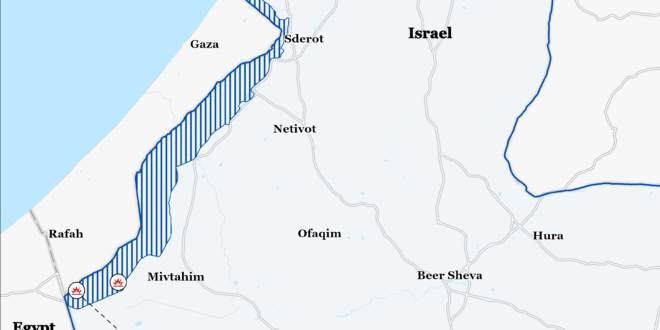Information Cutoff: 2:00 pm ET
The Iran Update provides insights into Iranian and Iranian-sponsored activities abroad that undermine regional stability and threaten US forces and interests. It also covers events and trends that affect the stability and decision-making of the Iranian regime. The Critical Threats Project (CTP) at the American Enterprise Institute and the Institute for the Study of War (ISW) provides these updates regularly based on regional events. Click here to see CTP and ISW’s interactive map of Israeli ground operations. This map is updated daily alongside the static maps present in this report. Click here to subscribe to the Iran Update.
CTP-ISW defines the “Axis of Resistance” as the unconventional alliance that Iran has cultivated in the Middle East since the Islamic Republic came to power in 1979. This transnational coalition is comprised of state, semi-state, and non-state actors that cooperate to secure their collective interests. Tehran considers itself to be both part of the alliance and its leader. Iran furnishes these groups with varying levels of financial, military, and political support in exchange for some degree of influence or control over their actions. Some are traditional proxies that are highly responsive to Iranian direction, while others are partners over which Iran exerts more limited influence. Members of the Axis of Resistance are united by their grand strategic objectives, which include eroding and eventually expelling American influence from the Middle East, destroying the Israeli state, or both. Pursuing these objectives and supporting the Axis of Resistance to those ends have become cornerstones of Iranian regional strategy.
We do not report in detail on war crimes because these activities are well-covered in Western media and do not directly affect the military operations we are assessing and forecasting. We utterly condemn violations of the laws of armed conflict and the Geneva Conventions and crimes against humanity even though we do not describe them in these reports.
Key Takeaways:
- Gaza Strip: Israeli forces launched a raid targeting Palestinian militias in Sabra and Zaytoun neighborhoods of Gaza City.
- Political Negotiations: Hamas stated that it will engage the latest Israeli proposal constructively, so long as the proposal meets Hamas’ maximalist demands.
- West Bank: Israeli forces engaged Palestinian fighters in eight locations across the West Bank.
- Southern Lebanon and Golan Heights: Lebanese Hezbollah conducted 11 attacks into northern Israel.
- Iraq: The Islamic Resistance in Iraq claimed a drone attack targeting Israel.
- Yemen: The Houthis claimed six drone and missile attacks targeting commercial and US naval vessels.
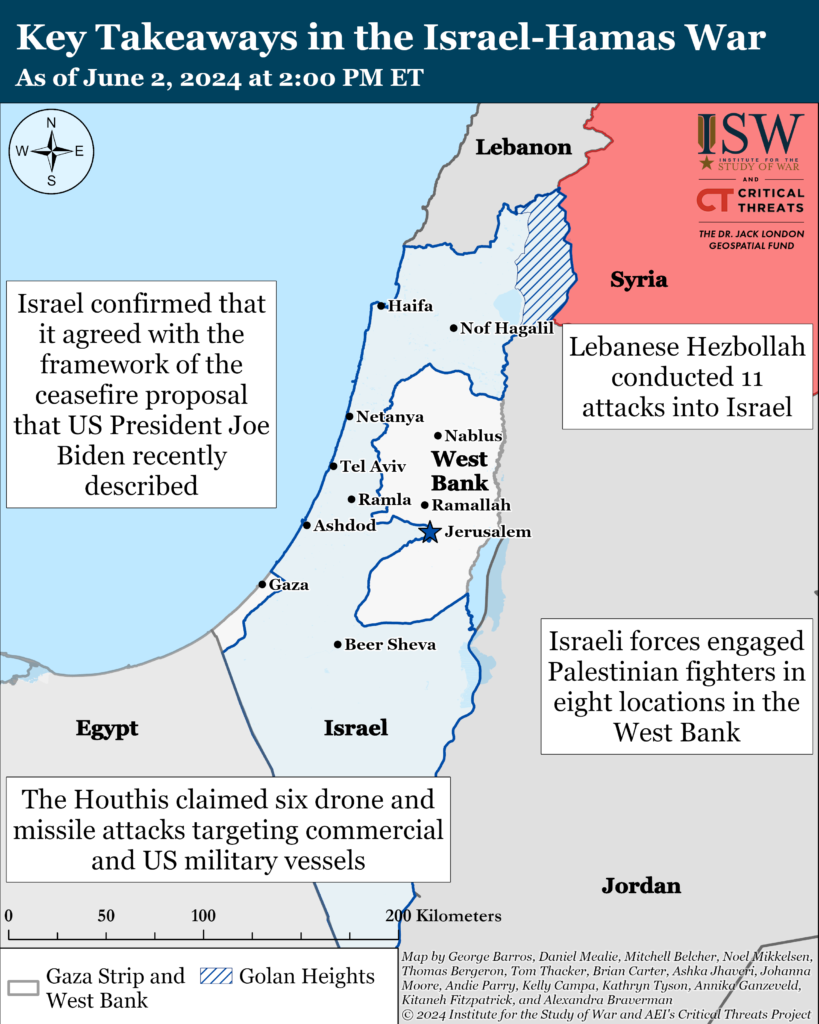
Gaza Strip
Axis of Resistance objectives:
Erode the will of the Israeli political establishment and public to sustain clearing operations in the Gaza Strip
Reestablish Hamas as the governing authority in the Gaza Strip
The Israel Defense Forces (IDF) announced on June 1 that it launched a raid into Sabra and Zaytoun neighborhoods of Gaza City.[i] Israeli forces have conducted multiple operations in this area of Gaza City throughout the war.[ii] The IDF deployed its joint special operations multidimensional unit and two reserve brigades under the 99th Division for the raid.[iii] The IDF said on June 2 that the multi-dimensional unit cooperated with the IDF Air Force to attack a Palestinian militia squad in a building.[iv] The IDF 99th Division is currently operating along the Netzarim Corridor, which the IDF uses to launch raids against Hamas fighters and infrastructure in the northern and central Gaza Strip.[v] Palestinian militias conducted attacks targeting Israeli forces along the corridor and in Sabra.[vi] CTP-ISW has previously stated that Hamas exploits the IDF raid-based model to protect Palestinian forces and facilitate reconstitution efforts.[vii]
Israeli forces continued clearing operations in several sectors of Rafah on June 2. The IDF confirmed that its Givati Brigade has advanced into Yabna refugee camp.[viii] Palestinian militias have claimed several attacks targeting Israeli forces around the camp since May 28.[ix] The IDF said on May 31 that its units are operating in central Rafah, where the camp is located.[x] Israeli forces located weapons in the camp, including anti-aircraft machine guns.[xi] Israeli forces engaged Palestinians fighters near the Philadelphi Corridor, of which the IDF said it took control on May 29.[xii]
Unspecified US and Israeli officials said that Israel adjusted its military operations in Rafah to avoid crossing the US Joe Biden administration’s red lines.[xiii] Israel originally planned to deploy two divisions to conduct clearing operations in Rafah.[xiv] The United States expressed concern that such action could increase civilian casualties significantly.[xv] President Biden said on May 8 that the United States will stop supplying Israel with certain weapons if Israel conducts a major military operation into Rafah.[xvi] The latest reporting is consistent with other reports that Israel was planning a limited attack targeting Hamas in Rafah and that the IDF is moving “more deliberately” in Rafah.[xvii]
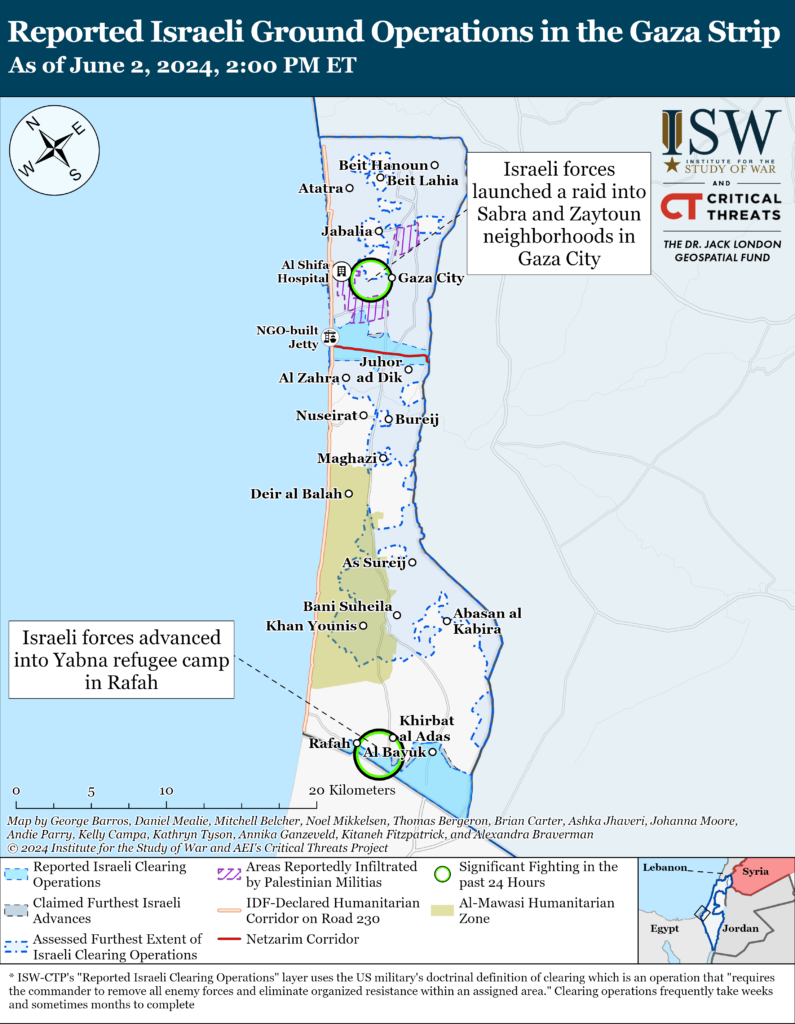
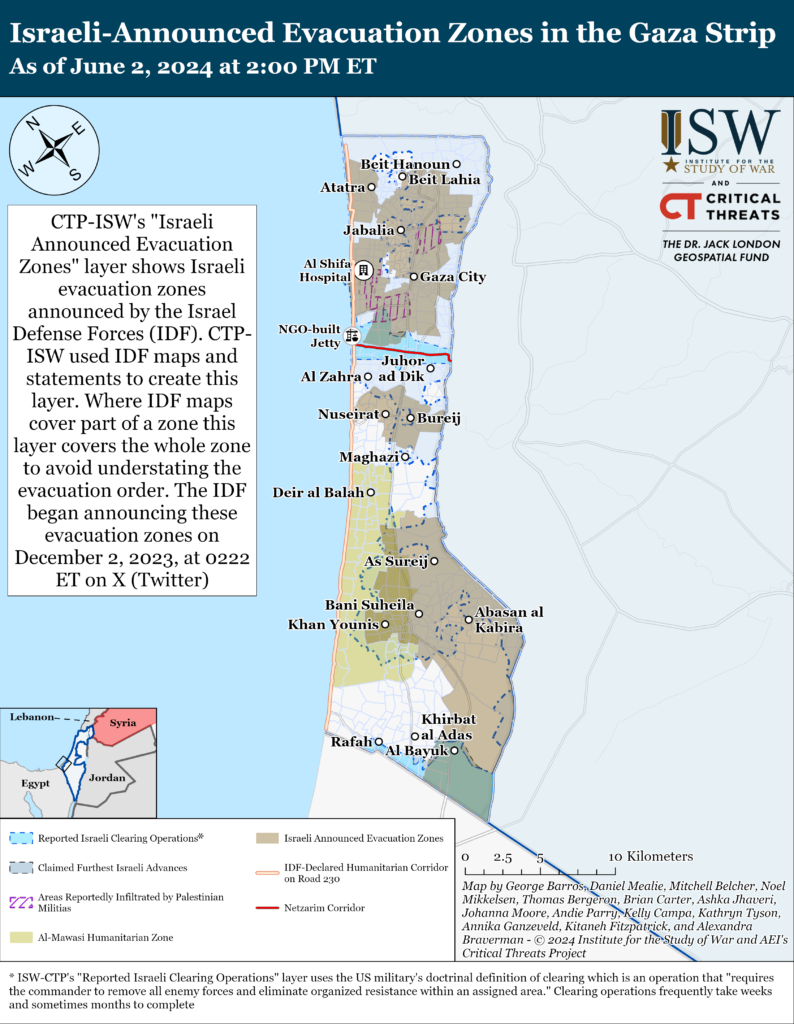
Hamas stated on May 31 that it is willing to engage “positively and constructively” with the latest Israeli ceasefire proposal, so long as it meets Hamas’ maximalist demands.[xviii] Hamas restated that its demands are a permanent ceasefire, the withdrawal of Israeli forces from the Gaza Strip, the reconstruction of the Gaza Strip, the return of displaced Palestinians, and a “genuine” prisoner swap deal.[xix] Hamas was responding to a speech on May 31 from US President Joe Biden, who urged Hamas to accept the latest Israeli ceasefire proposal. The proposal outlines three phases that include the withdrawal of Israeli forces and a permanent ceasefire.[xx] Biden did not specify how many Israeli hostages or Palestinian prisoners would be released in this proposal, nor did he specify the length of phases two and three. Hamas’ response to the speech does not necessarily reflect a change in its position.
US officials stated that Biden’s speech aimed to garner international support for the proposal and increase pressure on Hamas to accept the deal.[xxi] Biden warned that Hamas’ rejection of the proposal could lead to an escalation of the war. A senior US official mentioned that the proposal is “nearly identical” to one presented by Hamas three weeks prior.[xxii] The United States, Qatar, and Egypt published a joint statement on June 2 calling for Israel and Hamas to agree to the ceasefire proposal that Biden referenced in his speech.[xxiii]
Israel confirmed on June 1 that it agreed with the framework of the ceasefire proposal that President Biden described.[xxiv] Ophir Falk, who is a senior adviser to Israeli Prime Minister Benjamin Netanyahu, confirmed that Israeli approves the deal but also noted that a permanent ceasefire would only be possible once Israel achieves all its war aims. US officials expressed optimism, noting that Israel did not oppose Biden’s speech or dispute that it accurately reflected the latest Israeli proposal.[xxv]
An Israeli intelligence source confirmed on June 2 that Hamas killed a clan leader in the Gaza Strip, disrupting an Israeli plan to replace Hamas as the primary governing authority in the strip.[xxvi] Israel tried to persuade the Dughmush clan to assume responsibility from Hamas. The clan leaders were reportedly open to such discussions.[xxvii] Hamas then killed the clan leader, which CTP-ISW assessed at the time was meant to reassert Hamas control of the northern Gaza Strip. Israeli security analyst Ronen Solomon noted that no other force in the southern Gaza Strip is as powerful as the Dughmush clan. Senior Israeli officials are now working to find credible alternative rulers for the strip, aiming to persuade younger, more moderate Fatah members to govern and coexist with Israel.[xxviii] Hamas has been rebuilding its military and governing authority in the northern Gaza Strip since Israeli forces reduced their presence in December 2023. Hamas has a long history of violently suppressing political opposition in Gaza, and this incident highlights its determination to thwart Israeli efforts to replace it.
Palestinian militias conducted two indirect fire attacks into Israel on June 2.[xxix] The Democratic Front for the Liberation of Palestine fired rockets at an IDF site.[xxx] The Popular Front for the Liberation of Palestine fired rockets at Israeli forces near the Kerem Shalom border crossing between Israel and the Gaza Strip.[xxxi] Kerem Shalom is the main entry point for humanitarian aid into the Gaza Strip.
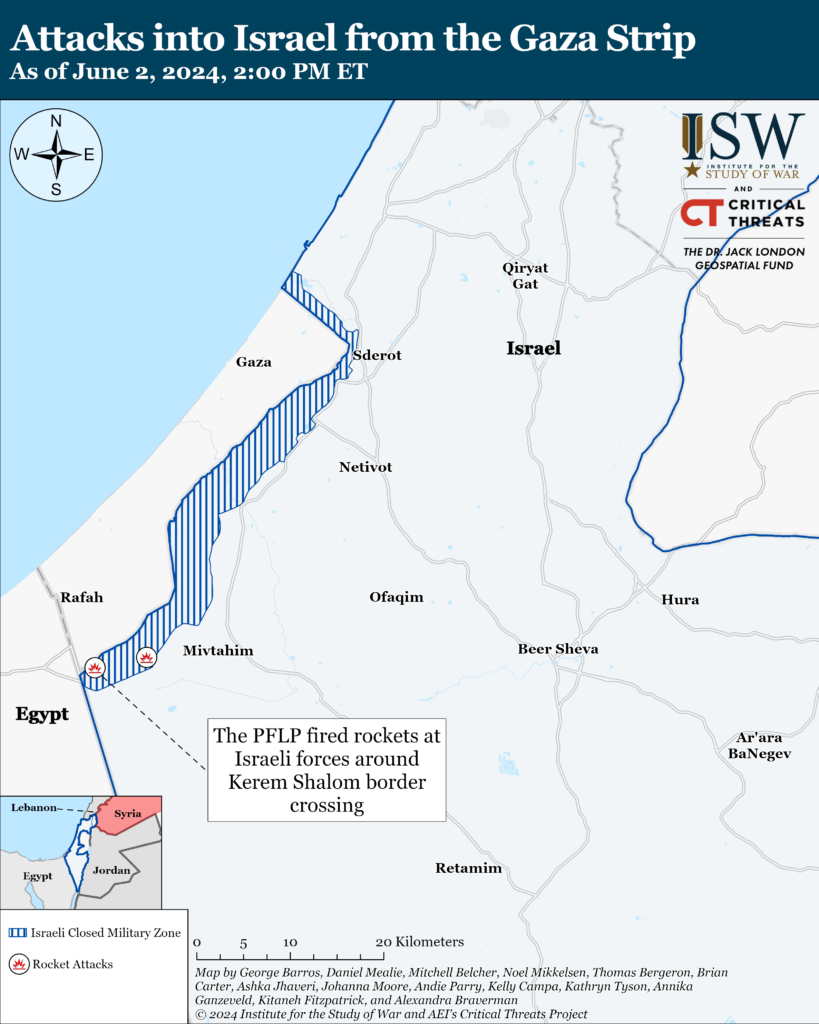
Recorded reports of attacks; CTP-ISW cannot independently verify impact.
West Bank
Axis of Resistance objectives:
Establish the West Bank as a viable front against Israel
Israeli forces have engaged Palestinian fighters in at least eight locations in the West Bank since CTP-ISW’s last data cut off on June 1.[xxxii]
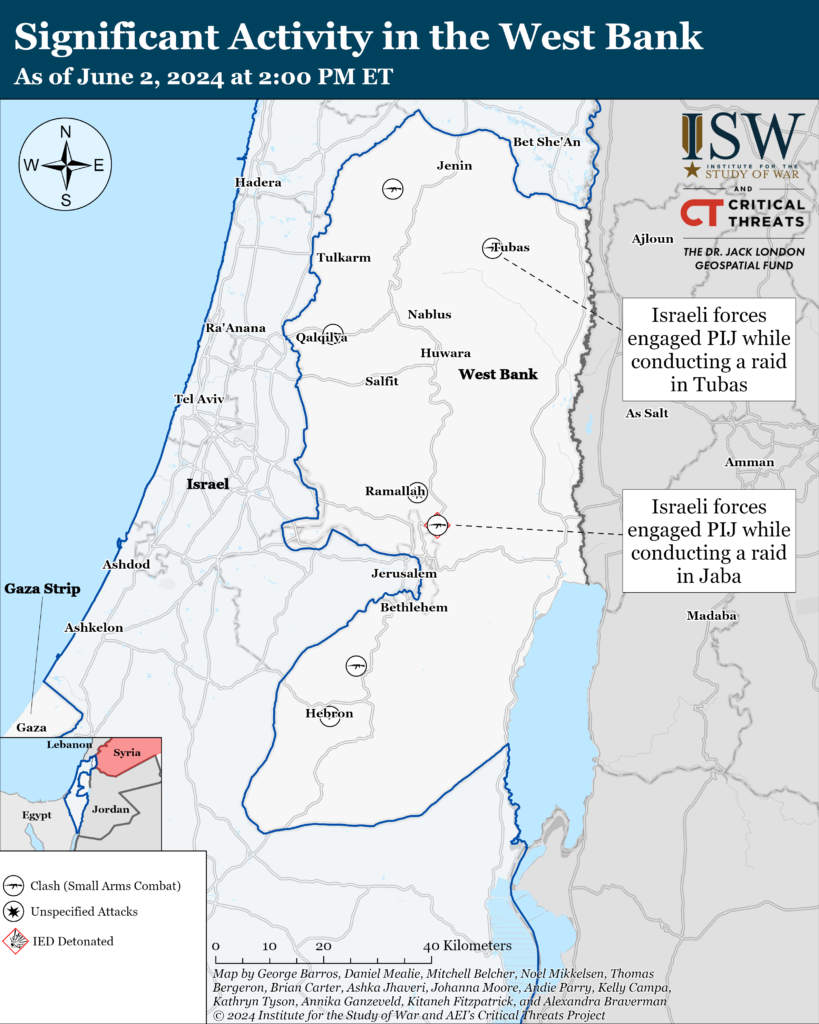
This map is not an exhaustive depiction of clashes and demonstrations in the West Bank.
Southern Lebanon and Golan Heights
Axis of Resistance objectives:
Deter Israel from conducting a ground operation into Lebanon
Prepare for an expanded and protracted conflict with Israel in the near term
Expel the United States from Syria
Lebanese Hezbollah has conducted at least 11 attacks into northern Israel since CTP-ISW’s last data cutoff on June 1.[xxxiii] The IDF intercepted an aerial target in northern Israel, which caused alarms near Nahariya.[xxxiv] Neither Hezbollah nor a Palestinian militia has claimed responsibility for the attack at the time of this writing.
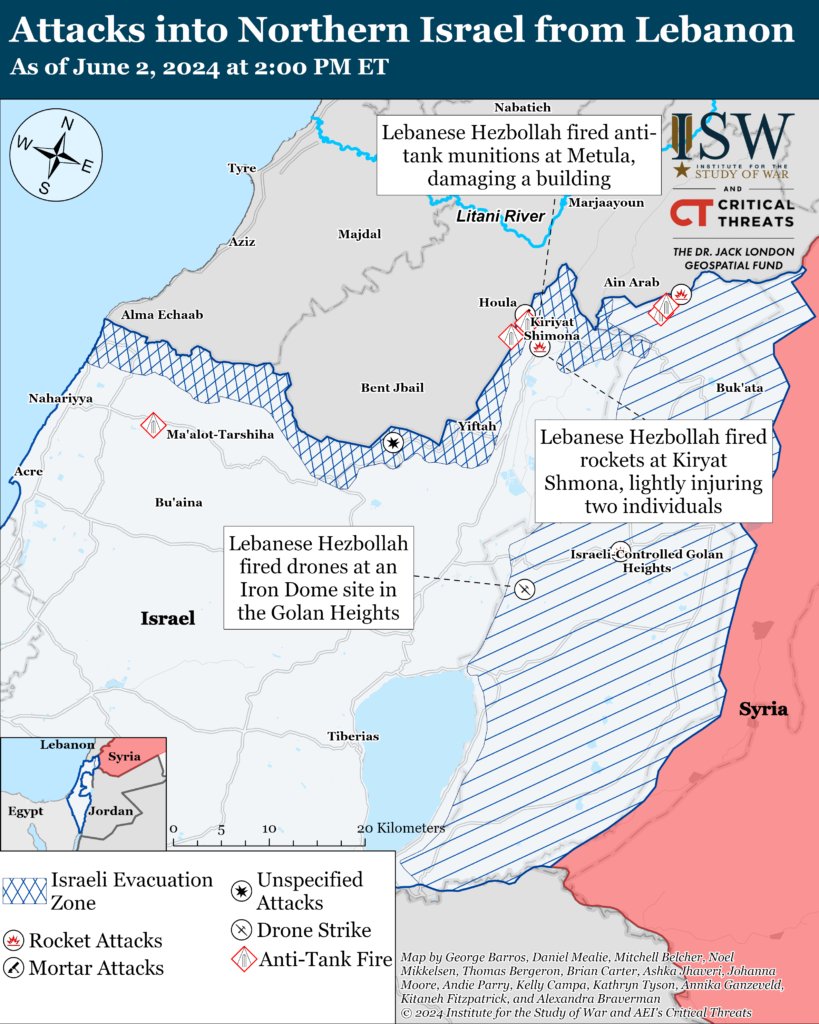
Recorded reports of attacks; CTP-ISW cannot independently verify impact.
Iran and Axis of Resistance
The Islamic Resistance in Iraq—a coalition of Iranian-backed Iraqi militias—claimed a drone attack targeting an unspecified “vital target” in Eilat on June 1.[xxxv] Israeli officials and media have not commented on the attack at the time of this writing.
The Houthis claimed six drone and missile attacks targeting US Navy ships and merchant vessels in the Red Sea, Arabian Sea, and Indian Ocean on June 1.[xxxvi] The Houthis claimed that they conducted two attacks targeting the US aircraft carrier USS Dwight D. Eisenhower north of the Red Sea in the past 24 hours.[xxxvii] The Houthis purportedly used drones and missiles in the first attack and unspecified weapons in the second attack.[xxxviii] There is no evidence that these attacks occurred. The Houthis also claimed they “directly hit” a US destroyer in the Red Sea using drones.[xxxix] US Central Command (CENTCOM) reported that it intercepted two Houthi anti-ship ballistic missiles targeting the USS Gravely destroyer in the southern Red Sea on June 1.[xl] The Houthis additionally claimed two attacks targeting the Malta-flagged MAINA merchant vessel in the Red Sea and the Arabian Sea, one attack targeting the Marshall Islands-flagged AL ORAIQ LNG tanker in the Indian Ocean, and one attack targeting the Malta-flagged ABLIANI crude oil tanker in the Red Sea.[xli] CENTCOM reported that it intercepted one Houthi drone in the southern Red Sea on June 1 and that two other Houthi drones crashed into the Red Sea without causing damage or injuries.[xlii] The United Kingdom Maritime Trade Operations reported that a vessel observed an explosion “a significant distance from the vessel” approximately 48 nautical miles southwest of al Hudaydah, Yemen, in the southern Red Sea on June 1.[xliii]
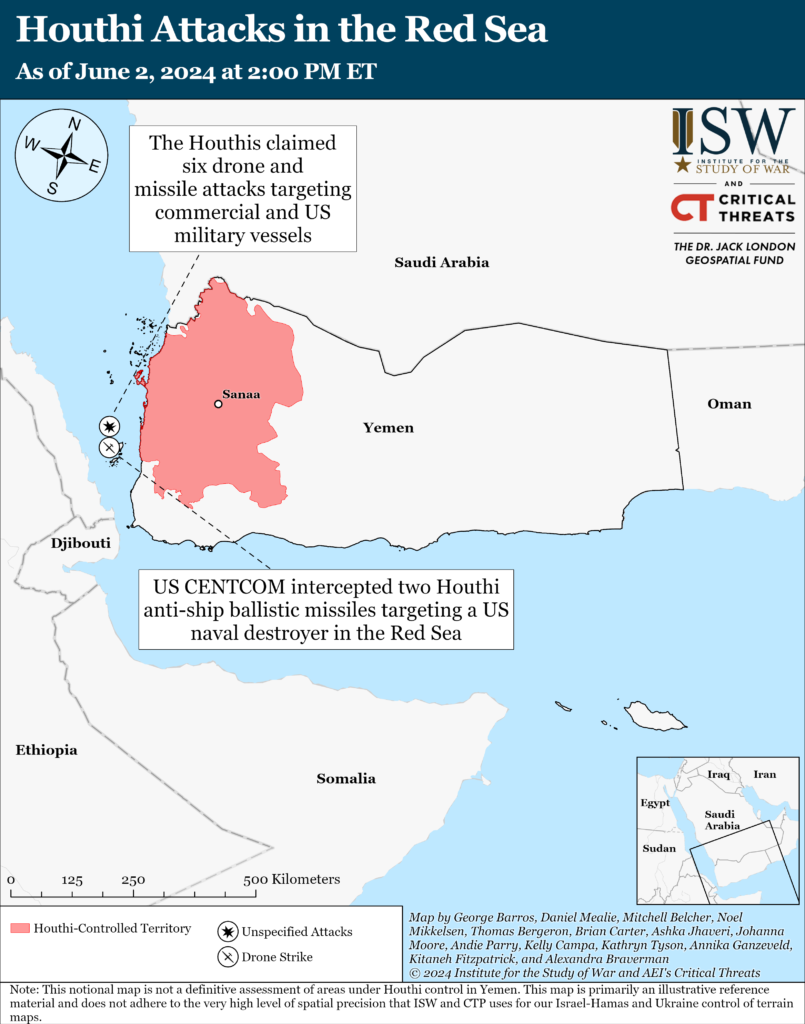
 Eurasia Press & News
Eurasia Press & News
